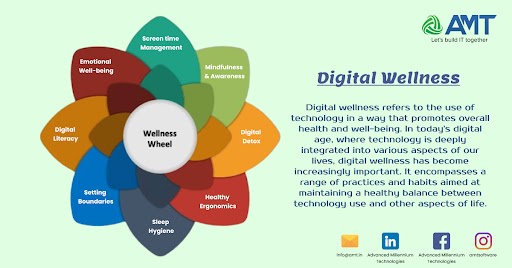Digital wellness refers to the use of technology in a way that promotes overall health and well-being. In today’s digital age, where technology is deeply integrated into various aspects of our lives, digital wellness has become increasingly important. It encompasses a range of practices and habits aimed at maintaining a healthy balance between technology use and other aspects of life.
Key components of digital wellness include:
- Screen Time Management: Controlling the amount of time spent on digital devices, especially smartphones, computers, and tablets. Excessive screen time has been linked to various health issues, including eye strain, sleep disturbances, and sedentary behavior.
- Mindfulness and Awareness: Being mindful of one’s digital habits and their impact on overall well-being. This involves staying present and focused on the current moment, rather than being overly consumed by digital distractions.
- Digital Detox: Taking intentional breaks from digital devices to reduce stress and enhance mental health. This may involve activities such as unplugging from social media, turning off notifications, or taking a break from screens altogether.
- Healthy Ergonomics: Paying attention to the ergonomics of digital device usage to prevent physical strain and discomfort. This includes maintaining proper posture, using ergonomic furniture, and taking breaks to stretch and move.
- Sleep Hygiene: Establishing healthy sleep patterns by minimizing screen time before bedtime. The blue light emitted by screens can interfere with the body’s natural sleep-wake cycle, making it important to create a tech-free wind-down routine.
- Setting Boundaries: Establishing clear boundaries for technology use, both in terms of time and activities. This might involve designating specific times for work, leisure, and personal activities, as well as setting limits on social media and other digital engagements.
- Digital Literacy: Developing the skills and knowledge to navigate the digital world safely and effectively. This includes understanding online privacy, recognizing digital misinformation, and being aware of the potential negative impacts of excessive technology use.
- Emotional Well-being: Focusing on the emotional and psychological aspects of digital well-being. This involves being aware of how digital interactions and social media can affect one’s mental health and taking steps to foster positive online experiences.
Digital wellness is a holistic concept that encourages individuals to use technology in a way that enhances their lives rather than detracts from it. By adopting mindful and intentional approaches to digital use, individuals can promote their overall well-being in an increasingly digital-centric world.
Here are some additional aspects and strategies related to digital wellness:
- Technology Sabbaticals: Taking periodic breaks from technology, such as a weekend without screens or a longer digital detox vacation. This allows individuals to recharge and engage in offline activities.
- Digital Environment: Creating a positive and organized digital environment. This includes decluttering digital spaces, organizing files and apps, and customizing settings to minimize distractions.
- Purposeful Technology Use: Being intentional about the use of technology by focusing on activities that align with personal or professional goals. This involves avoiding mindless scrolling and ensuring that technology use contributes positively to one’s life.
- Fitness and Activity Tracking: Using technology to promote physical well-being, such as fitness apps, activity trackers, and online workout programs. These tools can help individuals stay active and maintain a healthy lifestyle.
- Cybersecurity Awareness: Being mindful of online security and privacy to prevent potential risks and protect personal information. This includes using strong passwords, updating software regularly, and being cautious about sharing sensitive information online.
- Digital Support Networks: Leveraging technology to build and maintain meaningful connections. This includes using social media and communication apps to stay connected with friends and family, especially for those who may be geographically distant.
- Tech-Free Zones and Times: Designating specific areas or times where technology is not allowed. For example, keeping bedrooms free of screens or having tech-free family meals can foster better in-person connections.
- Digital Education and Skill Development: Continuously learning about new technologies and developing digital skills. This can empower individuals to use technology more effectively and make informed decisions about its use.
- Balance in Online Content Consumption: Striving for a balanced and diverse diet of online content. Being mindful of the type and amount of information consumed online, and ensuring that it aligns with personal values and interests.
- Self-Reflection: Regularly reflecting on one’s digital habits and making adjustments as needed. This may involve assessing the impact of technology use on overall well-being and making conscious choices to promote a healthier balance.
Digital wellness is a dynamic concept that evolves as technology advances and societal norms change. Adopting a proactive and mindful approach to digital habits can contribute to a healthier and more fulfilling life in the digital age.
Above is a brief about Digital Wellness. Watch this space for more updates on the latest trends in Technology.
